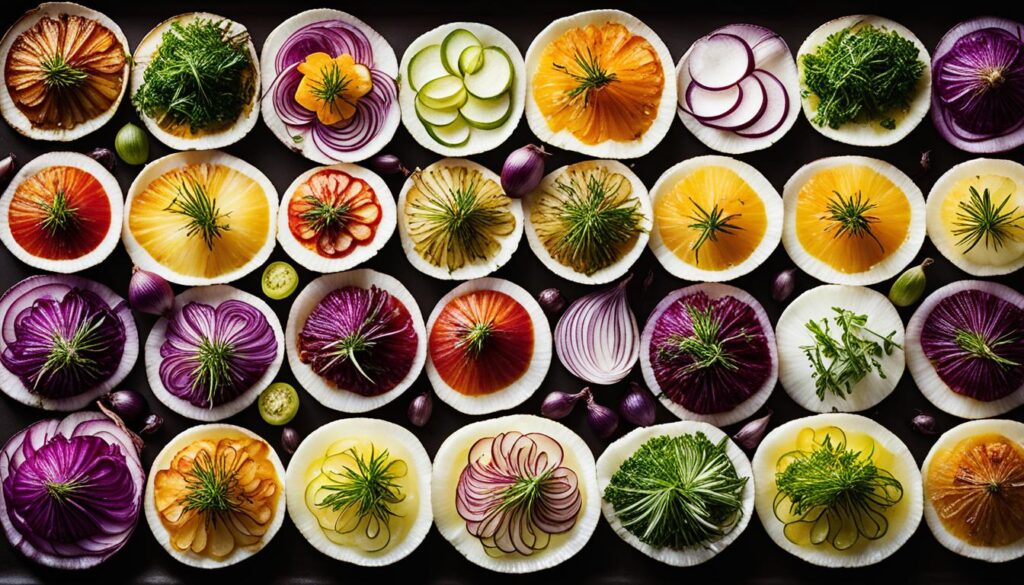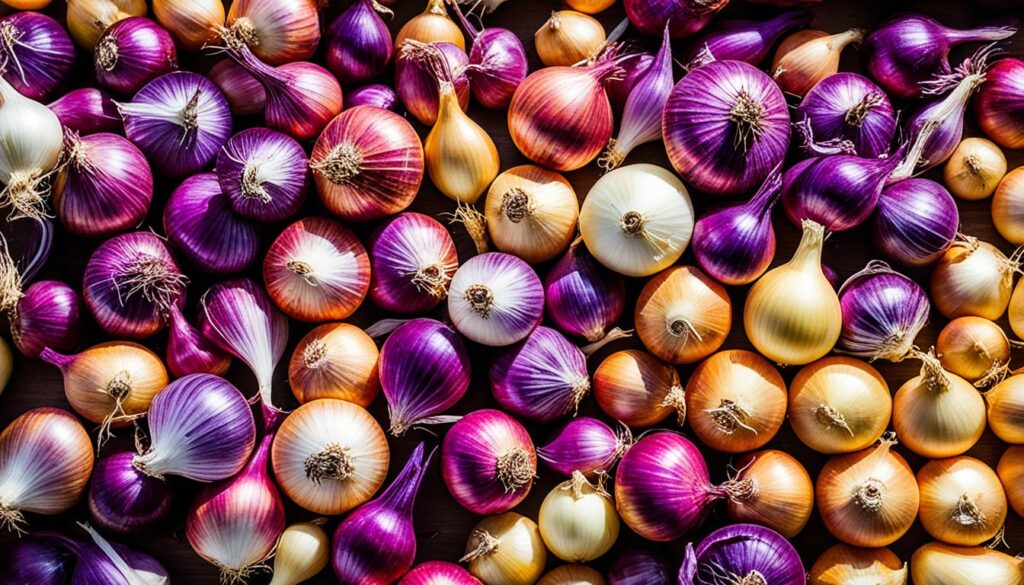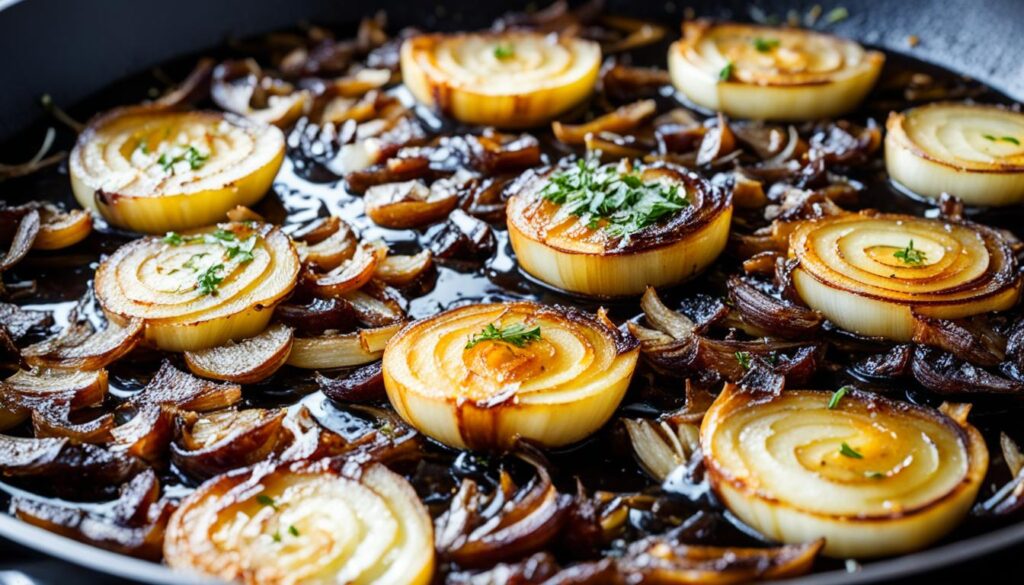Do you really get the most out of onions in your cooking? These simple bulbs are more than just a base ingredient. They are a key ingredient that can make any dish taste great. Onions add flavor to salads, sauces, soups, and stews.
This guide will show you the many sides of onions. We’ll look at their unique traits, how to use them in cooking, and how to prepare them. Whether you’re a pro chef or a beginner, you’ll learn how to make onions a must-have in your kitchen. Get ready to take your cooking to the next level with these amazing aromatics.
Discover the Incredible Versatility of Onions
Onions are more than just a side in cooking. They are versatile and can be used in many ways. They add flavor to every dish they are in, from raw to cooked.
From Salads to Sauces, These Aromatics Elevate Every Dish
Raw onions are crisp and have a strong taste. They are great on salads, sandwiches, burgers, and tacos. Marinating them in vinegar makes them perfect for salads or sandwiches.
Sautéing or caramelizing onions gives them a sweet, savory taste. This makes them great with rice, pasta, and meat dishes. Grilled onions add a smoky taste to burgers, brats, and baked beans. Stuffed or roasted whole onions are a tasty vegetarian main dish.

Onions are a true kitchen magic ingredient. They can turn any dish into something special. They are essential in every kitchen because of their versatility.
Varieties of Onions: A Flavorful Spectrum
The onion family, known as Alliums, offers a wide range of flavors. From yellow onions to red and white, each type is perfect for different dishes.
Yellow Onions: The Culinary Chameleon
Yellow onions are the most used and versatile. They have a sweet and sharp taste. This makes them great for many cooked dishes.
Their strong flavor works well when sautéed, caramelized, or roasted. They’re a key ingredient in soups, stews, and sauces.
Red Onions: Vibrant and Flavorful
Red onions are loved for their bright color and sweet, mild taste. They’re perfect for raw dishes like salads and salsas. Their crisp texture and flavor stand out.
White Onions: Clean and Pungent
White onions have a sharp, clean taste. They’re often used in Latin American and Mexican cooking. Their flavor is great with spicy dishes and in sauces.
Sweet Onions: A Gentle Allium
Sweet onions, like Vidalia or Walla Walla, are sweeter because they have less sulfur. They’re great raw or lightly cooked. Their mild flavor is perfect for burgers and sautéed dishes.
Scallions: A Delicate Allium Accent
Scallions, or green onions, are part of the Allium family. They have a light, onion taste. They’re often used as a garnish or added last to dishes for a subtle onion flavor.

Choosing any onion variety will add depth and flavor to your cooking. Try different onions to find your favorite.
Onions: Adding Depth and Flavor to Your Cooking
Onions are key in many savory dishes. They add a deep, complex taste to sauces, soups, stews, and braises. Whether chopped finely or caramelized, onions as a flavor base are vital for many meals.
Onions can also be the main attraction, like in French onion soup or caramelized onion tarts. They fit well in simple and complex dishes alike. This includes onions in sauces and soups, onions in stews and braises, and onions in baked dishes.
For caramelizing onions, yellow onions work best because of their rich flavor. Adding a bit of baking soda can speed up the process. Slicing onions lengthwise gives you crunchy slices, while crosswise or dicing makes them softer.
Cooking onions with a lid for 20 minutes helps them cook evenly. Then, remove the lid to let them brown. Adding water while caramelizing prevents burning and mixes in the tasty pan residue. A splash of vinegar at the end adds brightness and more flavor.
The Maillard reaction during caramelization creates deep flavors. Onions release amino acids that mix with sugar, making them taste nutty and almost meaty. This makes caramelized onions a great addition to many dishes.
Preparation Techniques for Maximum Flavor
Onions can change a dish’s taste if prepared right. They go from crisp and strong to sweet and caramelized. Learning how to handle onions can make your meals taste better.
Raw Onions: Crisp and Pungent
Raw onions keep their sharp taste and crunchy texture. They’re great for salads, sandwiches, and tacos. To avoid tears, soak them in cold water or freeze them first.
Caramelized Onions: Sweet and Indulgent
Cooking onions slowly over low heat makes them sweet and flavorful. This turns their natural sugars into a rich, caramel-like taste. Caramelized onions add depth to burgers, soups, and risottos.
Sautéed Onions: Savory and Aromatic
Cooking onions quickly over medium heat brings out their sweetness. It makes a savory base for sauces and stews. This method keeps onions’ texture and flavor.
Knowing how to prepare onions can make you a better cook. Try using raw, caramelized, and sautéed onions to find what you like best. This will help you use onions to their fullest.

The Humble Onion: An Essential Culinary Companion
Onions are a key ingredient in many cuisines, from Mexico’s vibrant salsas to France’s hearty stews. They add depth, sweetness, and savory flavors to dishes. Whether sautéed, caramelized, or raw, onions make home-cooked meals better.
Onions are also packed with nutrients like quercetin and allicin. These compounds are good for your health. The onion family includes everything from pungent shallots to sweet Vidalias. Using onions in your cooking can open up new possibilities and make simple ingredients special.
Exploring onions in global dishes or finding new ways to use them can make your meals better. Onions are great for salsas, sauces, roasted veggies, and caramelized dips. They are a must-have in the kitchen for their flavor and nutrition.



